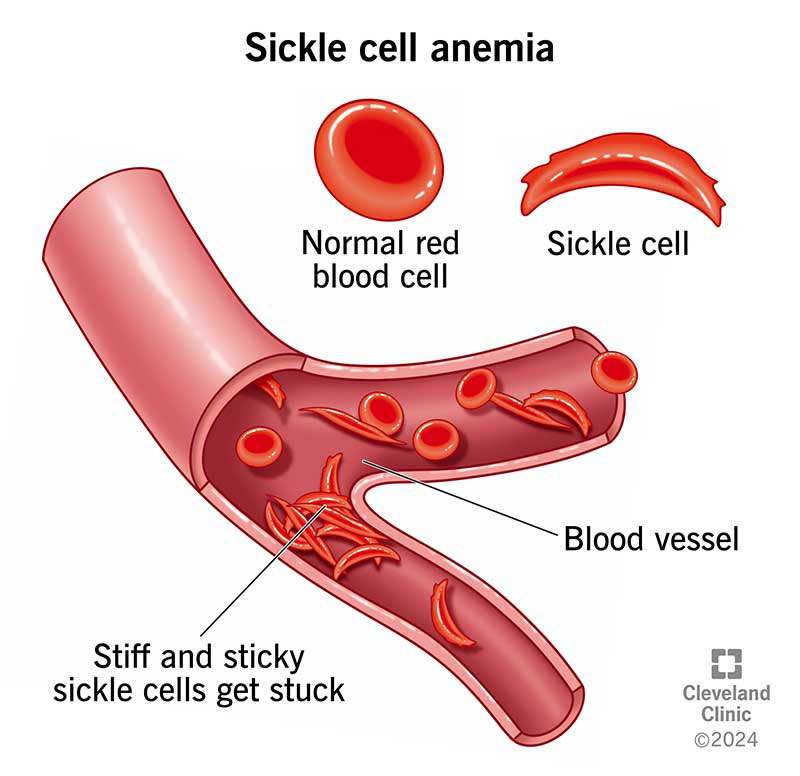An 18-year-old patient with a known history of sickle cell anemia presents to the emergency department with severe pain in the lower back and joints, fever, and signs of dehydration. What is the most appropriate initial nursing intervention?
Administer intravenous fluids and pain management as prescribed.
Apply cold compresses to the painful areas to reduce inflammation.
Administer antibiotics immediately to treat the underlying infection.
Encourage the patient to perform light exercise to promote circulation.
The Correct Answer is A
Choice A Reason:
Administering intravenous fluids and pain management is the most appropriate initial intervention for a patient with sickle cell anemia presenting with severe pain, fever, and dehydration. Sickle cell crises often lead to severe pain due to vaso-occlusion, where sickled red blood cells block blood flow to various parts of the body. Intravenous fluids help to rehydrate the patient and reduce blood viscosity, which can alleviate the vaso-occlusive crisis. Pain management is crucial to provide relief and improve the patient’s comfort. This approach addresses the immediate symptoms and stabilizes the patient.
Choice B Reason:
Applying cold compresses to the painful areas is not recommended for patients with sickle cell anemia. Cold can cause vasoconstriction, which may worsen the vaso-occlusion and increase pain. Instead, warm compresses are often suggested to help dilate blood vessels and improve blood flow.
Choice C Reason:
Administering antibiotics immediately is not the primary intervention unless there is a clear indication of an infection. While fever can be a sign of infection, it can also occur due to the inflammatory response associated with a sickle cell crisis. The priority is to manage pain and dehydration first, and then evaluate the need for antibiotics based on clinical findings.
Choice D Reason:
Encouraging the patient to perform light exercise is not appropriate during an acute sickle cell crisis. Physical activity can increase oxygen demand and exacerbate the pain and vaso-occlusion. Rest and adequate hydration are more suitable to manage the crisis effectively.

Nursing Test Bank
Naxlex Comprehensive Predictor Exams
Related Questions
Correct Answer is D
Explanation
Choice A Reason:
Primary hyperparathyroidism is characterized by elevated PTH levels, which lead to increased serum calcium levels and decreased serum phosphate levels. The patient’s lab results show low PTH and low serum calcium, which are not consistent with primary hyperparathyroidism.
Choice B Reason:
Chronic kidney disease (CKD) can cause disturbances in calcium and phosphate metabolism, but it typically presents with elevated PTH levels due to secondary hyperparathyroidism. The patient’s low PTH levels make CKD an unlikely diagnosis in this context.
Choice C Reason:
Vitamin D deficiency can lead to low serum calcium levels, but it usually results in elevated PTH levels as the body attempts to compensate for the low calcium. The patient’s low PTH levels do not align with a diagnosis of vitamin D deficiency.
Choice D Reason:
Hypoparathyroidism is characterized by low serum calcium, low PTH levels, and elevated serum phosphate levels. This condition occurs when the parathyroid glands do not produce enough PTH, leading to the observed lab results and symptoms such as tingling, muscle cramps, and fatigue. The patient’s lab results are consistent with hypoparathyroidism.
Correct Answer is A
Explanation
Choice A Reason:
Administering intravenous fluids and pain management is the most appropriate initial intervention for a patient with sickle cell anemia presenting with severe pain, fever, and dehydration. Sickle cell crises often lead to severe pain due to vaso-occlusion, where sickled red blood cells block blood flow to various parts of the body. Intravenous fluids help to rehydrate the patient and reduce blood viscosity, which can alleviate the vaso-occlusive crisis. Pain management is crucial to provide relief and improve the patient’s comfort. This approach addresses the immediate symptoms and stabilizes the patient.
Choice B Reason:
Applying cold compresses to the painful areas is not recommended for patients with sickle cell anemia. Cold can cause vasoconstriction, which may worsen the vaso-occlusion and increase pain. Instead, warm compresses are often suggested to help dilate blood vessels and improve blood flow.
Choice C Reason:
Administering antibiotics immediately is not the primary intervention unless there is a clear indication of an infection. While fever can be a sign of infection, it can also occur due to the inflammatory response associated with a sickle cell crisis. The priority is to manage pain and dehydration first, and then evaluate the need for antibiotics based on clinical findings.
Choice D Reason:
Encouraging the patient to perform light exercise is not appropriate during an acute sickle cell crisis. Physical activity can increase oxygen demand and exacerbate the pain and vaso-occlusion. Rest and adequate hydration are more suitable to manage the crisis effectively.

Whether you are a student looking to ace your exams or a practicing nurse seeking to enhance your expertise , our nursing education contents will empower you with the confidence and competence to make a difference in the lives of patients and become a respected leader in the healthcare field.
Visit Naxlex, invest in your future and unlock endless possibilities with our unparalleled nursing education contents today
Report Wrong Answer on the Current Question
Do you disagree with the answer? If yes, what is your expected answer? Explain.
Kindly be descriptive with the issue you are facing.
